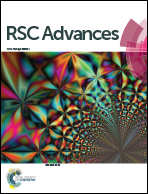Synthesis of nickel sulfide as a promising electrode material for pseudocapacitor application
Abstract
In the present investigation, in addition to pseudocapacitor application, the growth of interconnected nanorods/nanoplates of nickel sulfide (NiS) on a titanium (Ti)-substrate has been explored. An additive-free synthesis is performed by using a simple chemical bath deposition method. Structure and morphology of as-prepared NiS films are characterized by various characterization techniques such as X-ray diffraction, field effect scanning electron microscopy, high resolution transmission electron microscopy, and selected area electron diffraction etc. Electrochemical properties of the NiS thin film electrodes are studies by means of cyclic voltammetry and galvanostatic charge–discharge spectra obtained in 1 M aqueous KOH electrolyte. The NiS electrode demonstrates the notable pseudocapacitive activities including high specific capacitance (788 F g−1 at 1 mA cm−2), good rate capability (640 F g−1 at 50 mA cm−2), excellent cycling stability (98% retention after 1000 cycles) and high energy density (27.4 W h kg−1) as well as good power density (3.05 kW kg−1). Such an empirical performance is mostly due to the interconnected-type surface of NiS, which provides fast electron and ion transport. The obtained results indicate that the NiS thin film is a capable candidate as an electrode material for supercapacitor application.


 Please wait while we load your content...
Please wait while we load your content...